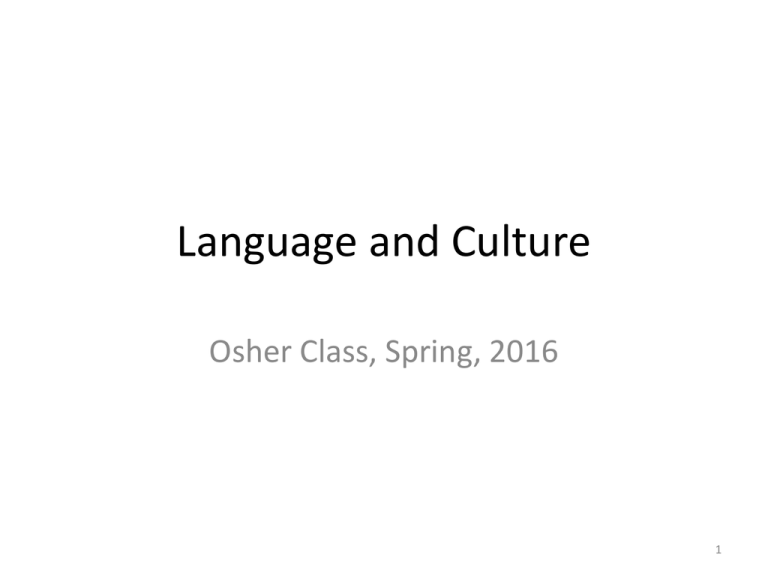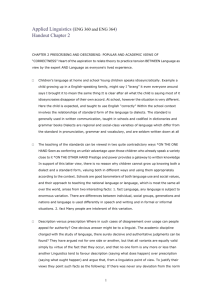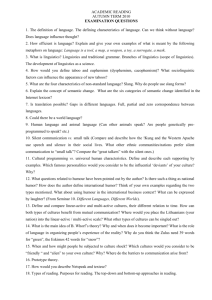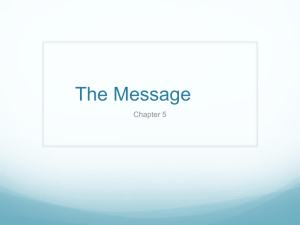Language and Culture Osher Class, Spring, 2016 1
advertisement

Language and Culture Osher Class, Spring, 2016 1 Topics for the Class • • • • • Brief History of Linguistics Brief History of Cultural Studies Aspects of Language Properties of Language Language competence vs Language performance • Linguistic components of Language • Non-linguistic components of Language • Body language and animal language • • • • • • • • • Language vs dialect Number of languages today Status of languages today What is Culture? Aspects of Culture Where is Culture? Numbers of Cultures today Past cultures and their influence Cultural competence vs cultural performance • Languages with no Culture • Translation • Can language influence culture? 2 Definitions – Language • The words, their pronunciation, and the methods of combining them used and understood by a community • A systematic means of communicating ideas or feelings by the use of conventionalized signs, sounds, gestures, or marks having understood meanings (non-verbal) 3 Definitions (con’t) – Culture • Acquaintance with and taste in fine arts, humanities, and broad aspects of science • The integrated pattern of human knowledge, belief, and behavior that depends upon the capacity for learning and transmitting knowledge to succeeding generations • The customary beliefs, social forms and material traits of a racial, religious, or social group • The set of shared attitudes, values, goals, and practices that characterizes an institution or organization 4 Definitions (con’t) -- Communication • A process by which information is exchanged thru a common system of symbols, signs, or behavior • Information transmitted or conveyed • A verbal or written message 5 C U LT U R E Communication Language Linguistic Components Sounds Words Syntax Non-linguistic components Kinesics Gestures Proxemics Semantics 6 A Brief History of Linguistics • • • • • • • • Sumarians Hindu Greeks Romans Arabs Hebrews Europe in the Middle Ages European explorers 7 8 History of Linguistics (con’t) • Grammars of known languages (19th century) • 20th century – Ferdinand de Saussure – father of modern linguistics – Noam Chomsky – created generative grammar of universal rules 9 A Brief History of Cultural Studies • Franz Boas – father of American anthropology • Creation of Centre for Cultural Studies (1964) • Richard Dawkins proposed the term “meme” – Can be a word or concept – STOP or – Can be a sound, picture, movie, a speech, etc. 10 Aspects of Language (Bollinger) • Language is: – – – – – – – Human Behavior Sound Hierarchic Embedded in gesture Both arbitrary and non-arbitrary Vertical and horizontal • Language changes to outwit change • Languages are similarly structured • Language is heard as well as spoken 11 Properties of Language (Bolton) • Language is productive/creative • Language is arbitrary • Language has duality • Language is discrete 12 How we know and use Language • Ferdinand de Saussure – Langue + parole = language • Noam Chomsky – Competence + performance = language 13 Linguistic Components of Language • Phonology (sounds) - /map/ /cap/ • Morphology (words) – map-s • Syntax (grammar) – The map is big. • Semantics (meanings) – John wears a cap. There is a salary cap. 14 Why we need the IPA • • • • • Cough Dough Thought Hiccough Lough Enough Through Plough Hough Thorough • A rough-coated, dough-faced, thoughtful ploughman strode through the streets of Scarborough; after falling into a slough, he coughed and hiccoughed. 15 Three levels of meaning • Lexical – the dictionary meaning • Structural or grammatical meaning • Socio-cultural meaning 16 Non-Linguistic Components of Language – Body Language • Kinesics • Gestures • Proxemics 17 18 Dialects of the U. S. 19 20 21 Dialects of Spain 22 Dialects of England 23 Number of World Languages • Population of the world - 7,106,865,254 • Number of Living Languages – 7,102 • 95% of the world’s people speak fewer than 100 of the world’s different languages • By 2050, many linguists predict that half of the world’s languages will disappear • An entire way of thinking is lost each time a language becomes extinct 24 Definition of Culture • Acquaintance with and taste in fine arts, humanities, and broad aspects of science • The integrated pattern of human knowledge, belief, and behavior that depends upon the capacity for learning and transmitting knowledge to succeeding generations • The customary beliefs, social forms and material traits of a racial, religious, or social group • The set of shared attitudes, values, goals, and practices that characterizes an institution or organization 25 Guernica by P. Picasso 26 Aspects of Culture • • • • • • • • • • It is learned Language is the medium of transmission It is applicable to all people It is active and dynamic It changes over time It is multilayered It is malleable/adaptive It is always considered within a context It is thick, thin, or compartmentalized It structures our perceptions 27 Where is Culture? • • • • • • • • • Food/health Personal hygiene Transportation Personal space Moral code Modesty Meals Social gatherings Birthdays/holidays • • • • • • • • • Clothing Family Time Religion Humor Attractions/revulsions Entertainment Gender roles Etc. 28 Examples of 21st Century Language • Texting – OMG – IMHO – BAY – BTW – CUL – OTOH – PAW – BRB 29 Examples (cont.) • Totesing (short for “totally”) – Totes tradge (tragic) – Totes emosh (emotional) – Bluebs – Subconch – Aphrodeez – Imposh – Fosh 30 Cultural Competence vs Cultural Performance • Knowing about – the gathering of cultural information • Knowing how – acquiring cultural behaviors • Knowing why – discovering cultural explanations • Knowing oneself – developing self-awareness 31 32 Dialects of the U. S. 33 Cultures of Europe 34 Cultures of the U. S. 35 Past Cultures and their Influence • • • • • • • Celts – whiskey, bog, shindig Anglo-Saxon – be, strong, water, the, you Latin & Greek – bishop, angel, demon Vikings – get, hit, leg, low, root, want, wrong Normans/French – many New World – hurricane, hammock Spanish – rodeo, avocado, algebra, arroyo 36 Origins of English Words 37 Created Languages • • • • • • • • The Hobbit, Lord of the Rings – J.R.R. Tolkien Lapine – Watership Down Newspeak – 1984 by George Orwell Atlantean – Atlantis: The Lost Empire Ku – The Interpreter Klingon, Vulcan – Star Trek Na’vi - Avatar Valyrian – The Game of Thrones 38 Esperanto • Alphabet – 26 letters: a b c ĉ d e f g ĝ h ĥ i j ĵ k l mnoprsŝtuŭvz • Sample structures: – Good morning – Bonan matenon – Good evening – Bonan vesperon – What is your name? – Kio estas via nomo? – Thank you – Dankon – Excuse me – Pardonu min 39 Basic Principles of Language • Language consists of a systematically organized set of oral/aural symbols. – Writing only imperfectly represents language • Associations between symbols and referents are essentially arbitrary. • The segmentation of experience by speech symbols is essentially arbitrary. • No two languages exhibit identical systems of organizing symbols into meaningful expressions 40 Grammar Differences • • • • • • • • • • • • • • • La leche es buena. Milk is good. Correspondence El hermano de David es guapo. David’s brother is handsome. Differences 41 What is involved 42 Language Influences Culture • Use of geographical location to express all locations and lapse of time • Perceptions, e.g., color affected by mother tongue • Gender-system languages where animate and inanimate things must have gender 43 Recap • Language and culture are inexorably intertwined • The combination allows us to communicate and be understood • We are linguistically and culturally competent • L & C can and do influence each other (more research needed) • Languages and Cultures are unique 44



